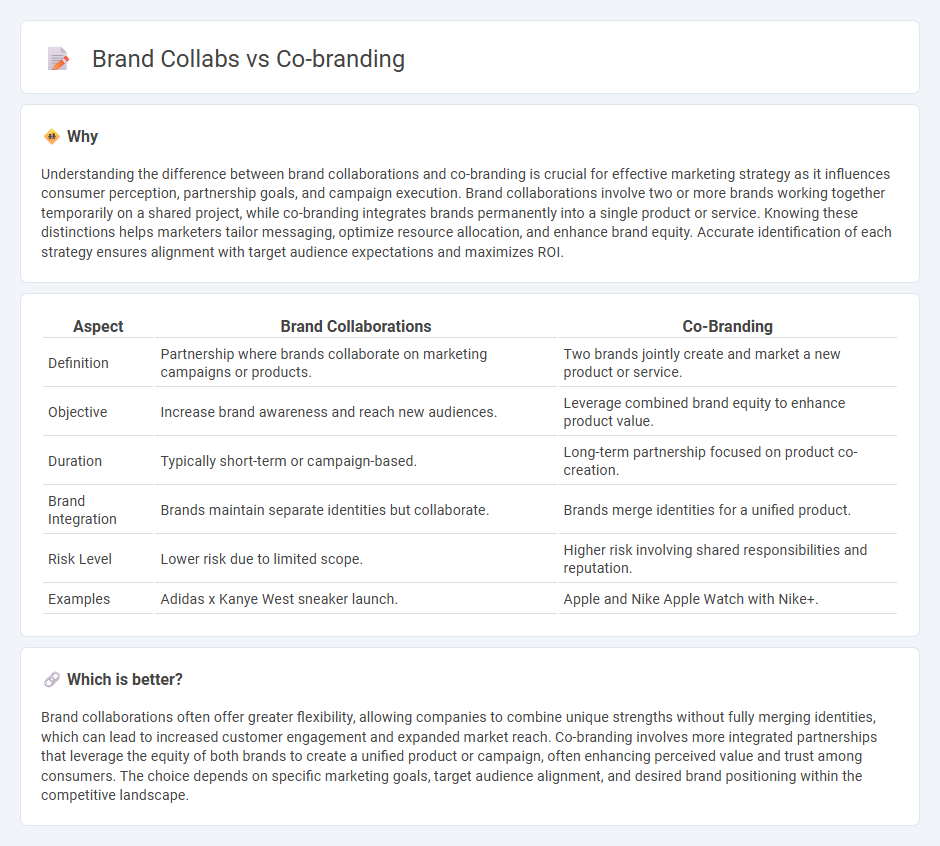
Brand collaborations involve two distinct companies working together on a specific campaign or product to leverage each other's audiences, while co-branding integrates both brand identities into a single product offering, enhancing mutual recognition and value. Successful brand collabs often focus on shared goals and short-term promotions, whereas co-branding aims for long-term partnership and sustained brand equity. Discover how these strategies can elevate your marketing efforts by exploring their key differences and benefits.
Why it is important
Understanding the difference between brand collaborations and co-branding is crucial for effective marketing strategy as it influences consumer perception, partnership goals, and campaign execution. Brand collaborations involve two or more brands working together temporarily on a shared project, while co-branding integrates brands permanently into a single product or service. Knowing these distinctions helps marketers tailor messaging, optimize resource allocation, and enhance brand equity. Accurate identification of each strategy ensures alignment with target audience expectations and maximizes ROI.
Comparison Table
| Aspect | Brand Collaborations | Co-Branding |
|---|---|---|
| Definition | Partnership where brands collaborate on marketing campaigns or products. | Two brands jointly create and market a new product or service. |
| Objective | Increase brand awareness and reach new audiences. | Leverage combined brand equity to enhance product value. |
| Duration | Typically short-term or campaign-based. | Long-term partnership focused on product co-creation. |
| Brand Integration | Brands maintain separate identities but collaborate. | Brands merge identities for a unified product. |
| Risk Level | Lower risk due to limited scope. | Higher risk involving shared responsibilities and reputation. |
| Examples | Adidas x Kanye West sneaker launch. | Apple and Nike Apple Watch with Nike+. |
Which is better?
Brand collaborations often offer greater flexibility, allowing companies to combine unique strengths without fully merging identities, which can lead to increased customer engagement and expanded market reach. Co-branding involves more integrated partnerships that leverage the equity of both brands to create a unified product or campaign, often enhancing perceived value and trust among consumers. The choice depends on specific marketing goals, target audience alignment, and desired brand positioning within the competitive landscape.
Connection
Brand collabs and co-branding are interconnected marketing strategies that combine the strengths and audiences of two or more brands to create unique products or campaigns. This partnership enhances brand visibility, credibility, and customer engagement by leveraging shared values and complementary offerings. Successful co-branding campaigns, such as Adidas x Gucci or Apple x Nike, illustrate how collaboration drives innovation and market differentiation.
Key Terms
Brand Partnership
Co-branding involves two brands merging their identities to create a single product or marketing campaign, enhancing recognition and shared value. Brand collaborations focus on partnership projects where brands leverage each other's strengths without fully integrating their identities, fostering innovation and expanding customer reach. Explore the nuances and strategic advantages of brand partnerships to elevate your marketing approach.
Joint Branding
Joint branding in co-branding involves two or more brands combining their names or logos on a single product to leverage mutual brand equity and reach broader markets. Brand collaborations, while also partnerships, often focus on limited-edition releases or campaigns that highlight creative synergy without merging brand identities. Discover how joint branding can elevate market presence and consumer trust through strategic brand alliances.
Collaborative Marketing
Co-branding and brand collaborations both leverage partnerships to enhance market reach but differ in structure; co-branding merges two brand identities into a single product offering, while brand collaborations involve joint marketing efforts without blending products. In collaborative marketing, strategic alignment of brand values and target audiences maximizes consumer engagement and drives mutual growth. Explore comprehensive strategies and examples to deepen your understanding of effective collaborative marketing.
Source and External Links
What Is Co-branding? - Airfocus - Co-branding is a partnership where two companies share brand elements on one product or project, combining marketing power and resources to boost trust, reach, and sales, with examples like Dell and Intel or Nike and Michael Jordan's Air Jordans.
What Is Co-Branding? Everything You Need To Know. - SmashBrand - Co-branding fuses two brands' strengths to create a product that enhances consumer appeal and market reach, relying on aligned values and strategies, such as the Nike+ collaboration between Nike and Apple.
Growing Your Business with a Co-Branding Strategy - Co-branding strategically aligns two or more brands based on shared values and complementary strengths to increase sales, reach, brand awareness, and value through a mutually beneficial partnership.
 dowidth.com
dowidth.com